Trekking poles often spark divided opinions—some people love them, others dislike them. There seems to be a certain “prejudice” against the image of the pole and its similarity to a cane. But many people who start using trekking poles never go back. They offer benefits such as improved balance during hikes, reduced load on the knees, decreased muscle strain, energy savings, and more. This article doesn’t aim to debate the pros and cons of using trekking poles, but rather to highlight key aspects that can influence your choice when buying one, and to present a comparison between models from Azteq, Guepardo, and NTK. This way, you’ll have the necessary information to choose your next trekking pole more wisely.
Introduction: better understanding trekking poles
We can classify trekking poles by their length, weight, material, and adjustment type. These characteristics, along with how you intend to use the pole, will determine the best model for you.
Adjustment type and length are the most important factors for most outdoor activity enthusiasts. Material and weight become more relevant for more demanding users or for activities where reducing weight can translate into better performance and energy efficiency.
Length of trekking poles
When we talk about trekking pole length, we must consider three key measurements:
1. The minimum length of the pole when collapsed;
2. The maximum length of the pole when fully extended;
3. The minimum usable length of the extended pole (a measurement that specifically affects compact models).
1. Minimum length when collapsed
The collapsed length determines how easy the pole is to carry. The more compact it is, the easier it will be to store in your backpack’s side pocket, a pannier (if you’re biking and hiking), or a trail running pack.
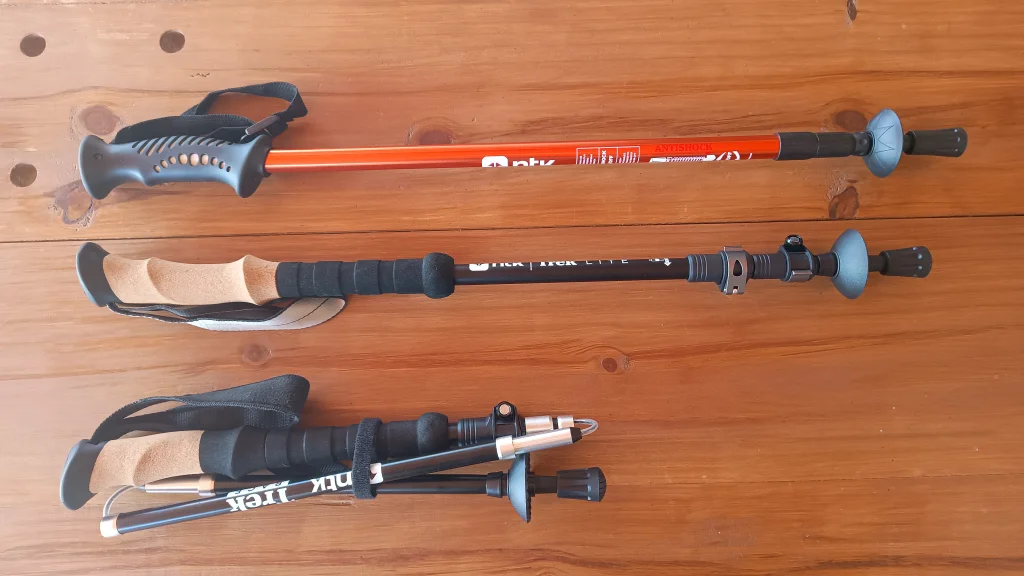
Notice the size difference between 3 trekking poles when fully collapsed.
Some poles can exceed 60 cm in length even when collapsed. This makes them harder to transport and may cause issues on narrow trails, as a long pole strapped to your backpack can get caught in vegetation.

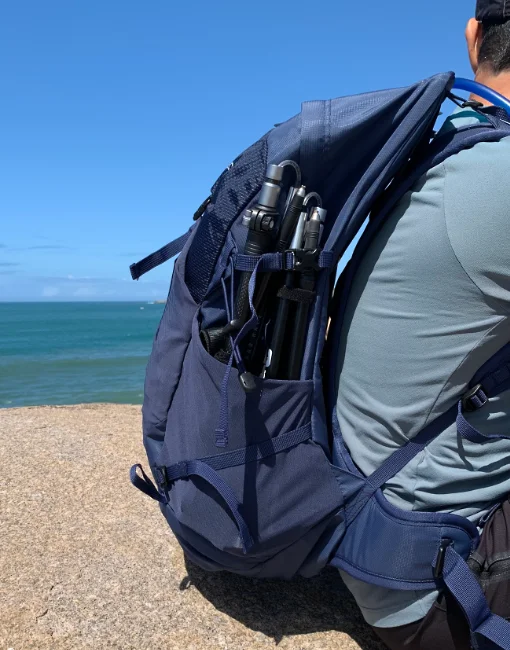
In the first image, there are two poles on a 36-liter backpack; in the second, a compact pole on a 32-liter backpack. Notice how part of the orange pole sticks out beyond the backpack. This is common with daypacks. To minimize this issue, you can use trekking pole holders available on some backpacks or opt for a more compact pole.
2. Maximum length when extended
The maximum extended length is usually not a problem for most users, but it may require attention for very tall people. You’ll need to adjust pole length depending on terrain—shorter for uphill, longer for downhill. The problem can arise on descents if the pole isn’t long enough to provide proper support for a tall person, even at its maximum length.
Most trekking poles for hiking, trekking, and trail running reach a maximum of 135 cm when fully extended. This might not be enough for people taller than 190 cm. While poles with 140 or 145 cm lengths do exist, they’re harder to find—especially in Brazil.
3. Minimum usable length when extended
This is a specific issue with compact trekking poles. These have become more common, especially among trail runners, adventure racers, and minimalist hikers. Poles like the ones shown below have a fixed minimum usable length, which can make them too long for shorter individuals (160 cm or shorter), even when adjusted to their minimum setting.
Below, we show a flip-lock trekking pole and a compact model, both set at their minimum usable length.
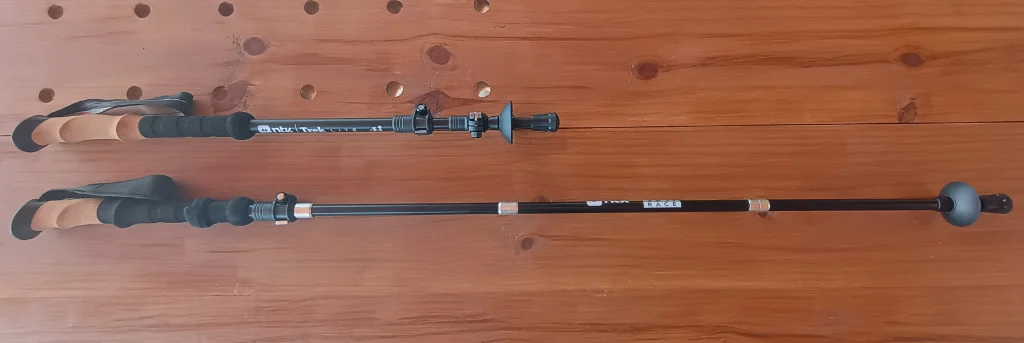
Two different poles: a flip-lock model (top) and a compact one (bottom). Both are set at their shortest usable length.
Outside of Brazil, trekking poles are often sold in various sizes to suit shorter individuals or teens. But such variations are not commonly available here. If you’re a shorter person, pay close attention when choosing this type of pole. This feature will also impact how you use them on ascents, where you’d ideally shorten them—but that may not be possible.
An example to help you better understand this issue
Many compact poles measure around 116 cm at their shortest setting. For someone who is 160 cm tall, the ideal pole length would be approximately 110 cm (to form a 90º elbow angle when the hand is on the grip and the tip touches the ground on flat terrain). That 6 cm difference may be enough to make the pole uncomfortable for some users.
Of course, some people have longer arms than others, but if you’re on the shorter side, it’s worth testing the pole in person before buying. All three compact poles presented in this comparison have a minimum length of 116 or 117 cm.
Types of Adjustment
The type of adjustment is another important feature in trekking poles. Basically, there are three different mechanisms for locking the segments of a trekking pole:
1. Twist lock: common in simpler models, to adjust the length you open a segment and twist it until it locks. This mechanism tends to wear out over time. It’s also not practical if you’re wearing gloves. Two poles mentioned in this article—the Guepardo Antishock and the NTK Trek Pro Antishock—use this locking system.
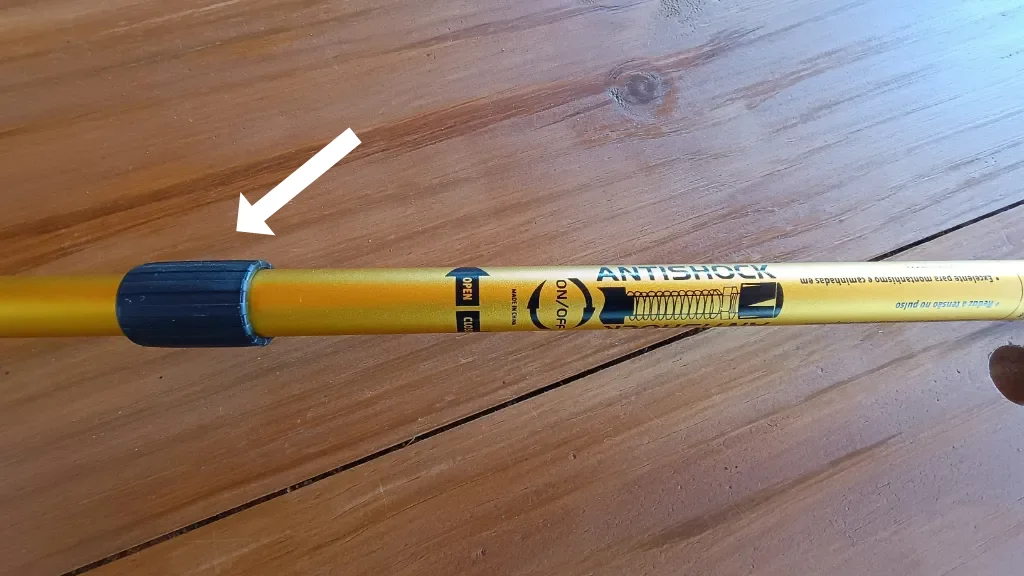
2. Flip lock (quick locks): practical and functional—just open the lock, adjust the segment, and close it again. They’re easy to use even while wearing gloves. This is my favorite type of adjustment due to its reliability, ease of use, and simplicity. The NTK Trek Lite pole featured in this article uses a flip-lock system.

3. Combination of flip lock and auto-lock: this is the adjustment system used in compact poles. The pole is initially locked with an automatic pin mechanism and then fine-tuned using a flip lock. This adjustment system is used in the three compact trekking poles featured in this comparison (Azteq Actos, Azteq Actos Pro Race Carbon, and NTK Trek Race).
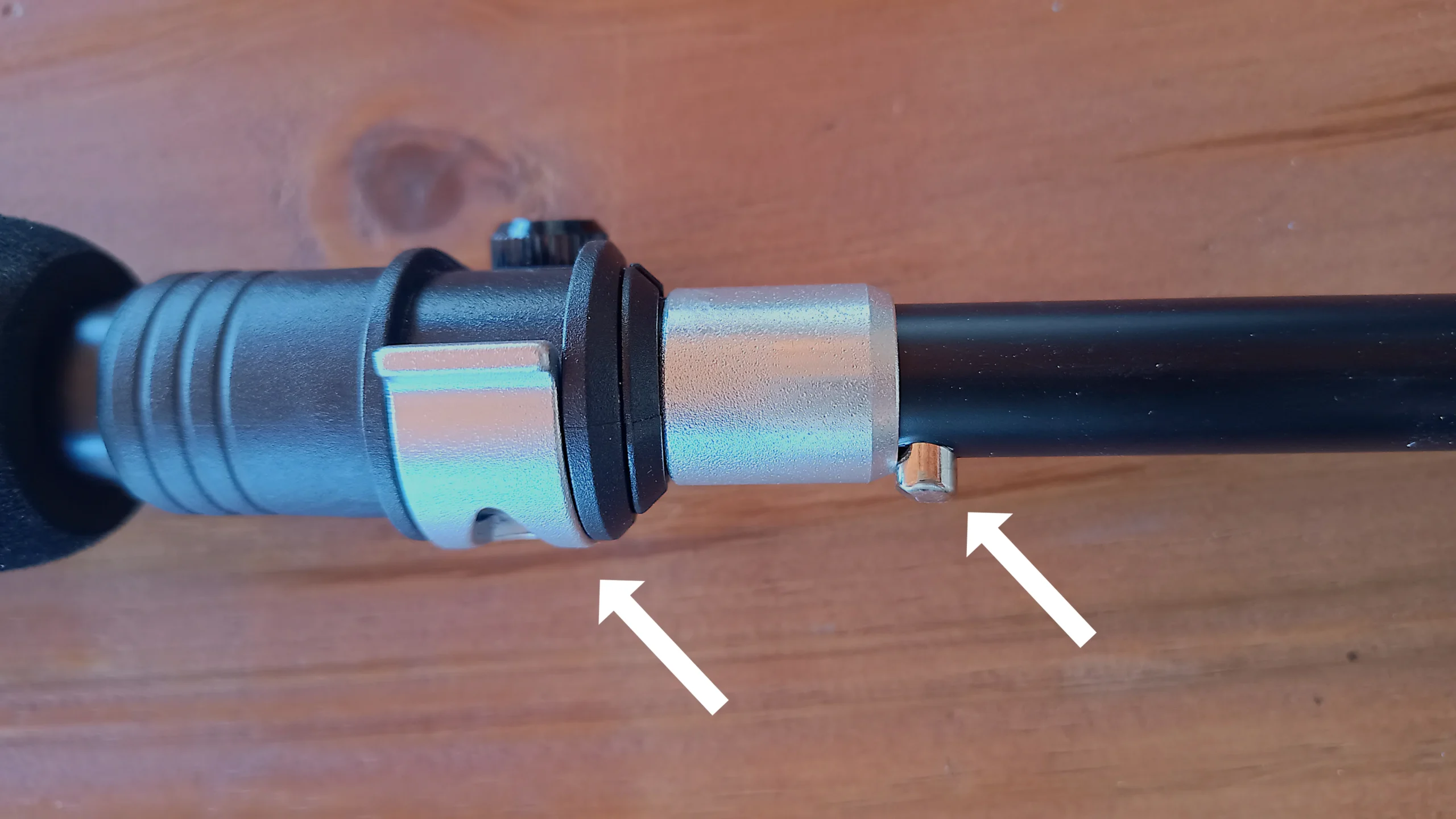
Materials and Weight
Trekking poles are typically made from one of two materials: aluminum (and aluminum-based alloys) or carbon fiber.
Aluminum is a traditional, lightweight, and durable material widely used in sports equipment. It also helps reduce the final cost of the product. Carbon fiber is a composite material that is even lighter and strong, making it a great choice for those who want to shave off some grams. However, carbon poles tend to be more expensive and are not always more durable.
Some poles are made from high-strength aluminum alloys, like “7075 Aluminum,” which is used in industries such as sports equipment, bicycles, automotive parts, and aviation. There are also poles that combine both materials—carbon and aluminum—using each in different parts of the shaft.
Carbon’s durability compared to aluminum is another key point to consider. While carbon fiber is highly resistant to tension, it doesn’t respond well to bending. It’s not uncommon to hear about carbon poles snapping under lateral stress or sudden impacts. For this reason, carbon might not be the best option for those hiking in rugged terrain, where poles can easily get caught between rocks or roots. Aluminum poles tend to flex or bend rather than snap, making them easier to repair on the trail in case of emergencies.
Environmental impact should also be considered. Aluminum is much easier to recycle than carbon fiber.
Other Details About Trekking Poles
1. Grip: these are usually made of EVA foam, rubber, or cork. Among these three options, cork and EVA are generally the most comfortable—especially if you sweat a lot—since rubber can become uncomfortable after a few hours of hiking with sweaty hands.
Some of the poles reviewed here feature an extended grip, which allows you to quickly change hand position while maintaining comfort, without needing to adjust the pole’s height. This is especially useful when the terrain changes from flat to uphill and you need to shift your grip quickly.
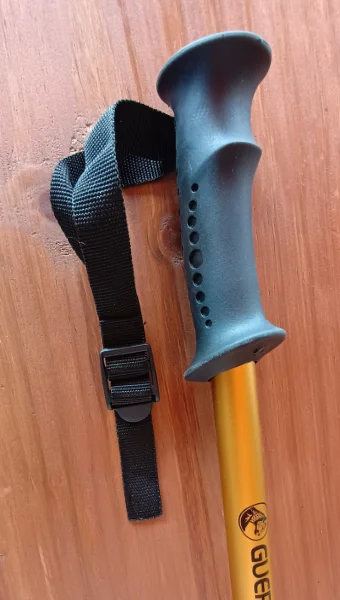
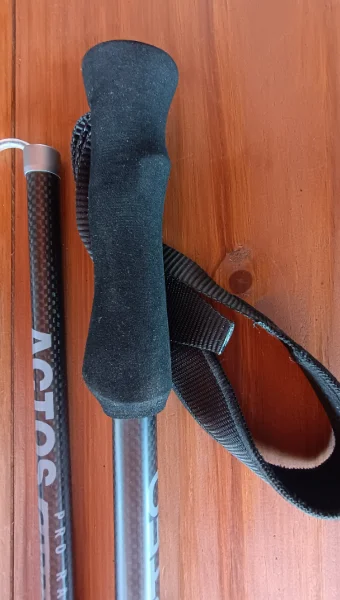

From left to right (or top to bottom) – Rubber grip, basic EVA grip, and extended cork with EVA grip
2. Adjustable wrist strap: most poles feature this. On some models, the straps are easier to adjust than others. Higher-quality poles usually have some kind of soft material, like suede or similar, to increase comfort. The strap helps prevent the pole from slipping out of your hand during movement, and also allows you to free your hand to do something else without having to drop the pole.
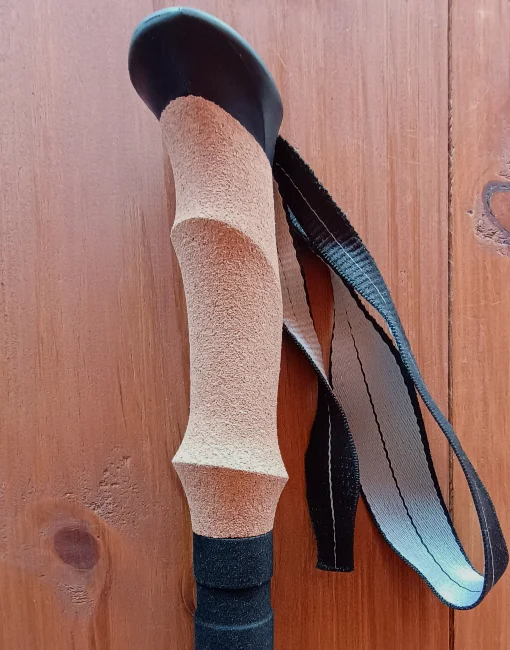
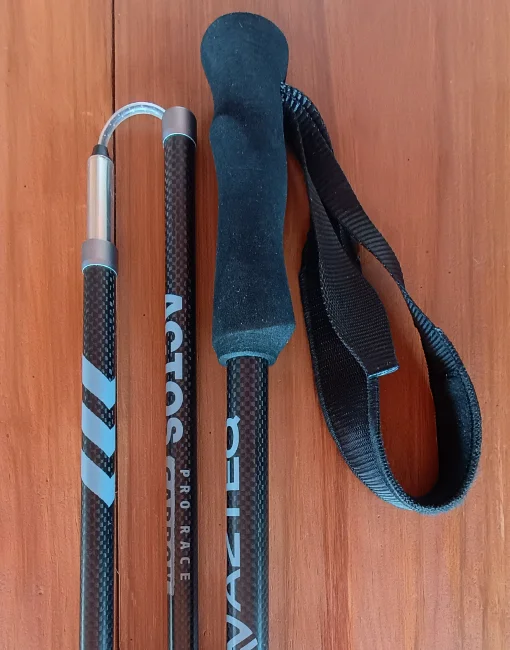
3. Accessories: trekking poles typically come with some accessories. The most common are baskets and rubber tips. Baskets are small discs that screw onto the bottom of the pole for use in sand, snow, or mud—conditions where the tip could sink more easily. In Brazil, it’s common for poles to come with a small basket suited for sand or mud.
In addition to baskets, some models come with rubber tips. There are two types: those designed for use during hikes to reduce environmental impact, and transport tips, which are intended to prevent the pole tip from scratching or tearing anything during travel.
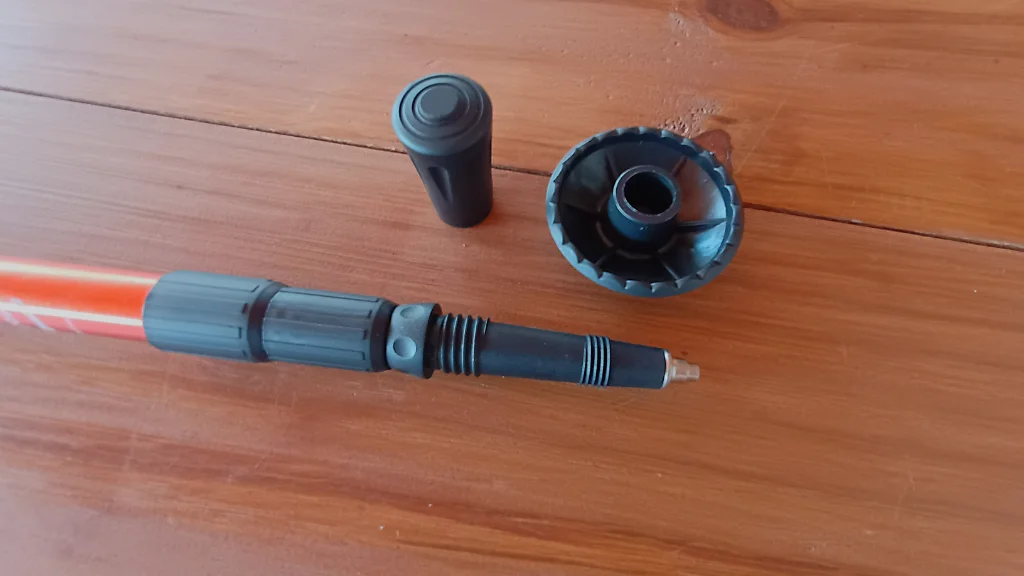
4. Single or pair: some brands only sell poles in pairs, while others sell them individually. In Brazil, it’s more common to find poles sold individually.
Now that you’re familiar with the basic features of trekking poles, let’s move on to the actual comparison of trekking poles.
Comparison of Trekking Poles – Azteq, Guepardo, and NTK
We will look at six different poles in this comparison: two entry-level models (one from NTK and one from Guepardo), and four higher-end models—two from Azteq and two from NTK. Most of the poles are made of aluminum, but one of them is made of carbon (Azteq Actos Pro Race Carbon).
NTK Trek Pro Antishock Trekking Pole
An entry-level pole with a twist-lock system and antishock mechanism (a small internal spring shock absorber). On this model, the antishock effect can be minimized using an internal locking system that allows greater or lesser spring movement. This lock is located inside the pole and engages with a small “click” when you twist the upper segment. In our testing, the lock did not completely disable the antishock, but it significantly reduced the spring’s range of motion.
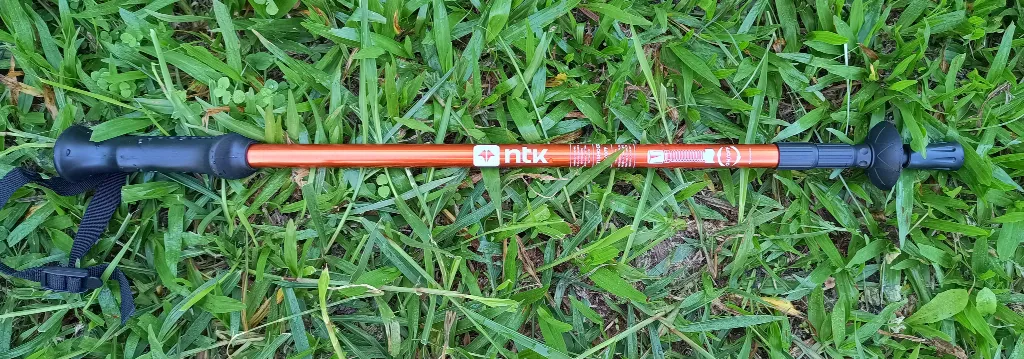
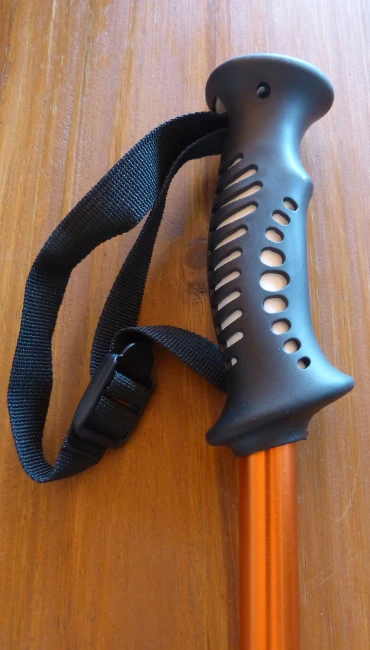
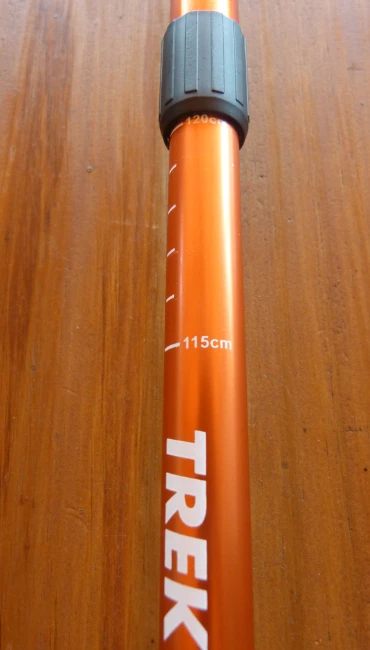
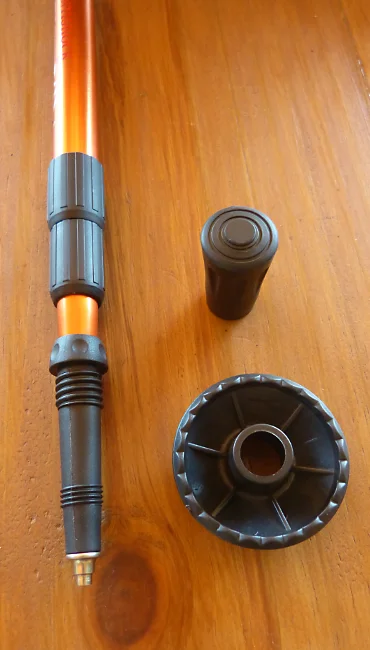
The wrist strap is basic, with plastic buckle adjustment. The rubber grip is not particularly comfortable and may feel small for users with larger hands. The antishock system works fine but isn’t a truly essential feature for trekking poles. The twist-lock system may jam and is harder to operate when wearing gloves.
One of the key aspects to note about this pole is its size. The NTK Trek Pro measures 66 cm when fully collapsed.
Take Note
- Affordable price;
- Suitable for users of all heights, even children;
- Comes with a small basket and rubber tip;
- Large when collapsed (66 cm);
- Basic grip that may be less comfortable for long hikes;
- Height markings in centimeters on only one segment of the pole;
- Not ideal for those needing a compact pole for running or fitting into the side pocket of a daypack.
Technical Specs
- Grip: basic EPS foam;
- Wrist strap: basic with plastic buckle adjustment;
- Collapsed length: approximately 66 cm;
- Maximum length: 135 cm;
- Weight: 295 g (without accessories);
- Basket weight: 8 g;
- Rubber tip weight: 16 g;
- Pole material: duralumin;
- Tip material: not specified by the manufacturer.
Guepardo Antishock Trekking Pole
The Guepardo Antishock pole is slightly lighter than the NTK Trek Pro Antishock, but otherwise the two share very similar characteristics. It is also quite large when collapsed, and the rubber grip is slightly smaller than that of the NTK Trek Pro, which could be a downside for users with larger hands.
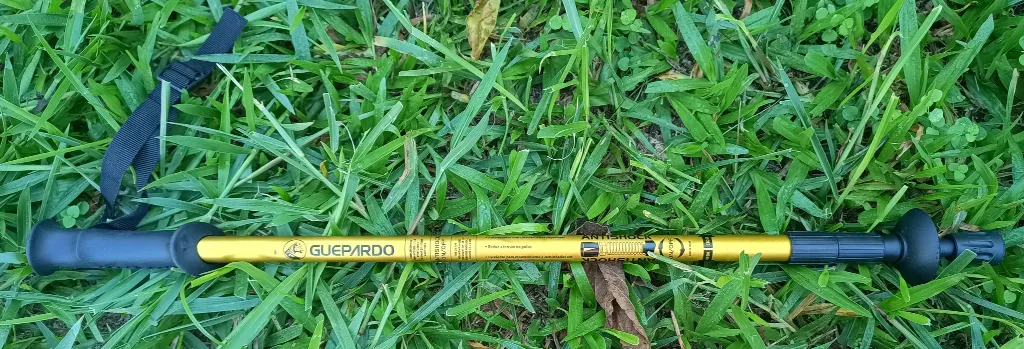
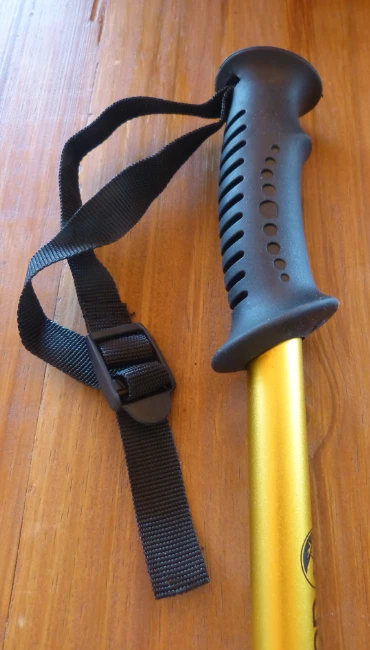

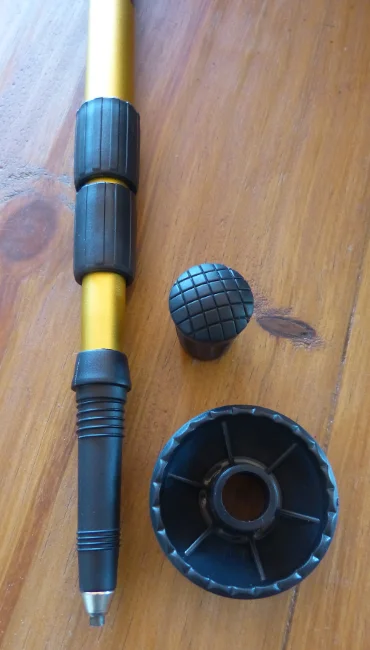
One small difference is that the Guepardo pole has height markings on both segments. This feature (shown in the photo below) is very useful when adjusting two poles to the same height.
Take Note
- Affordable price;
- Suitable for users of all heights, including children;
- Comes with a small basket and rubber tip;
- Large when collapsed (66 cm);
- Simpler and smaller grip—less comfortable for extended use;
- Height markings in centimeters on both segments for easier adjustment;
- Not ideal for those looking for a compact pole for running or for side pocket storage on a daypack.
Technical Specs
- Grip: basic rubber-coated polypropylene;
- Wrist strap: basic with plastic buckle adjustment;
- Collapsed length: approximately 64.5 cm;
- Maximum length: 135 cm;
- Weight: 265 g (without accessories);
- Basket weight: 8 g;
- Rubber tip weight: 14 g;
- Pole material: duralumin;
- Tip material: tungsten.
These two models are more basic and suited to users looking for budget-friendly options who aren’t concerned with factors like compact size, twist-lock systems, or less comfortable grips.
Azteq Actos Trekking Pole – Aluminum 7075
This is a different model from the previous two. The Azteq Actos aluminum version was the first compact trekking pole launched by NTK/Azteq, around 2018. Its standout features are the assembly system and its compact size when folded. The Actos uses a dual locking system—an automatic lock to secure the lower segments and a flip lock to extend the pole. However, this assembly system can be problematic for shorter users.
When extended, the Azteq Actos measures about 117 cm at its shortest setting, which means people under 165 cm may not adapt well to this pole—even though it features a comfortable cork and EVA grip that extends downward, increasing hand placement options.
The aluminum Actos is a well-built pole with a comfortable and adjustable wrist strap. It’s a great option for those seeking a compact, comfortable aluminum pole with fast setup. However, it weighs slightly more than the previous models.
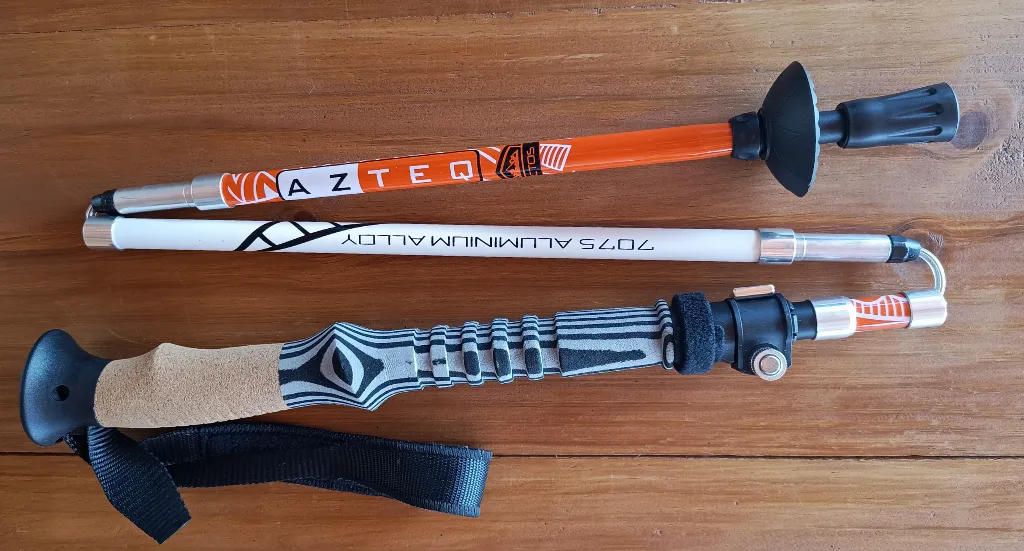
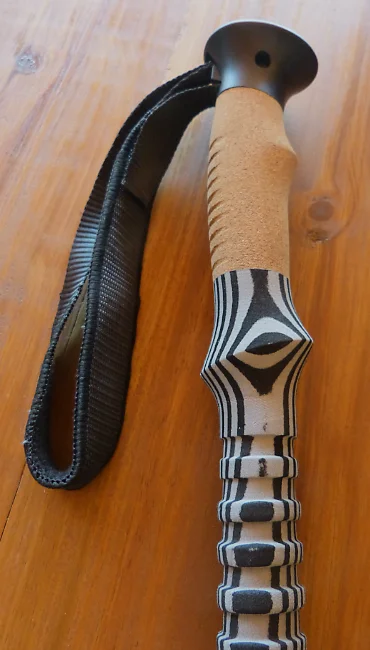
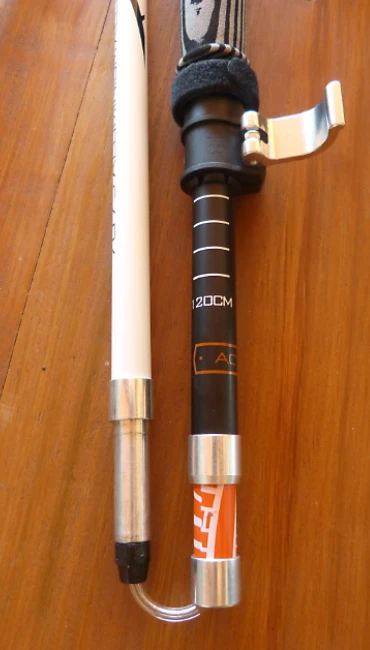
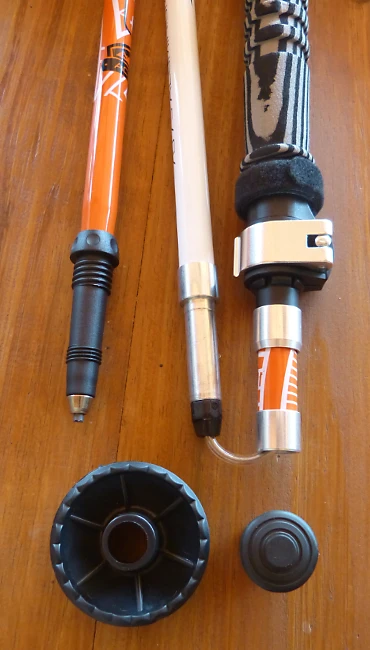
Take Note
- Well-built construction;
- Ideal for users 165 cm or taller;
- Includes a small basket and rubber tip;
- Compact when folded;
- Comfortable cork and EVA grip. Adjustable strap with a soft-touch finish;
- Centimeter markings for height adjustment;
- A great option for those seeking a compact, well-built, and affordable pole.
Technical Specs
- Grip: extended and ergonomic, made of cork and EVA;
- Wrist strap: adjustable with a soft-touch finish;
- Collapsed length: approximately 39.5 cm;
- Minimum extended length: 117 cm;
- Maximum extended length: 135 cm;
- Weight: 310 g without accessories;
- Basket weight: 8 g;
- Rubber tip weight: 14 g;
- Pole material: aluminum 7075;
- Tip material: tungsten.
Azteq Actos Pro Race Carbon Trekking Pole
This is the lighter, newer sibling of the Actos line. The Azteq Actos Pro Race Carbon weighs 210 g—100 g lighter than the aluminum version—making it ideal for trail running or hiking where a lightweight pole is preferred. The weight reduction impacts some features: this model has a comfortable, adjustable wrist strap and grip, but the grip is shorter and more basic. Personally, I found the carbon pole’s assembly process smoother and easier compared to the aluminum version.
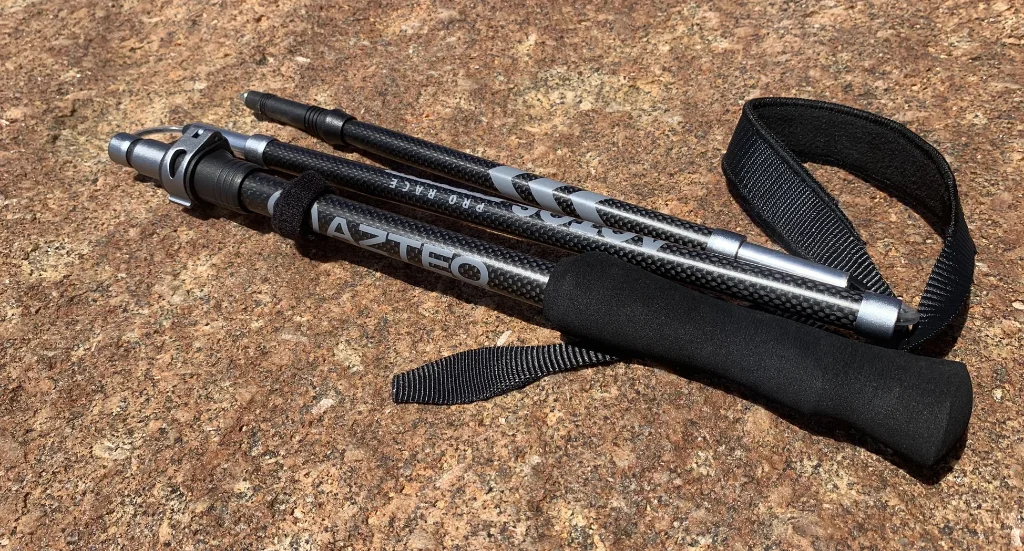
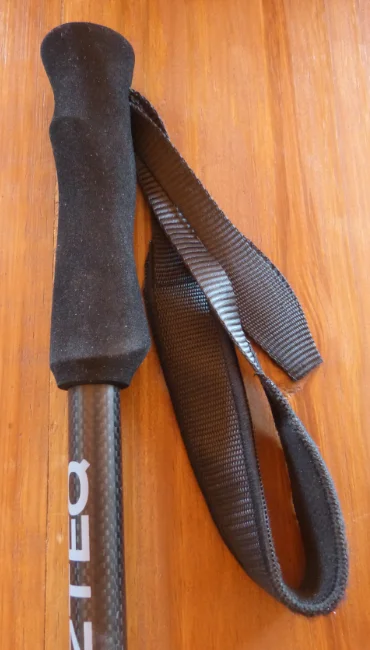
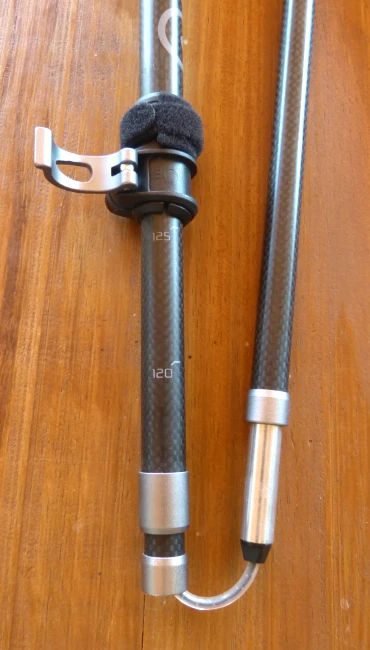
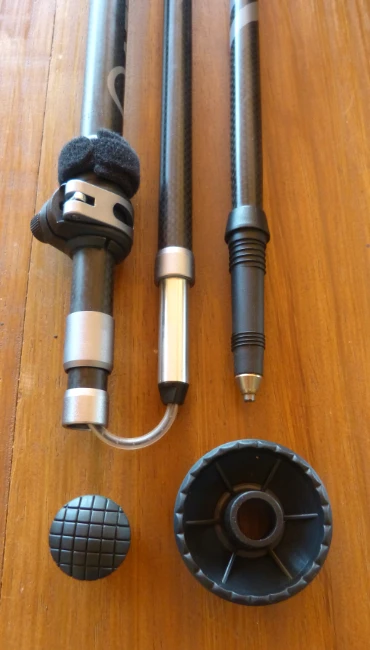
Take Note
- Lightweight and well-built;
- Ideal for users 165 cm or taller;
- Includes a small basket and rubber tip;
- Compact when folded;
- Short, comfortable EVA grip. Adjustable strap with a soft-touch finish;
- Centimeter markings for height adjustment;
- A good choice for those seeking a compact, lightweight carbon pole at a reasonable price.
Technical Specs
- Grip: EVA;
- Wrist strap: adjustable with soft-touch finish;
- Collapsed length: approximately 38.5 cm;
- Minimum extended length: 117 cm;
- Maximum extended length: 135 cm;
- Weight: 210 g without accessories;
- Basket weight: 8 g;
- Rubber tip weight: 14 g;
- Pole material: 50% carbon + 3K;
- Tip material: carbon steel.
NTK Trek Lite Trekking Pole
The NTK Trek Lite trekking pole is a great option for those who want a model slightly shorter than the two poles we presented at the beginning of this comparison. While it’s not as compact as the foldable models shown earlier, it has excellent features—such as the flip-lock adjustment system that makes it suitable for shorter users—and an extended grip. A solid choice for trail use, especially for those on a tighter budget who still want better technical quality than basic twist-lock models.
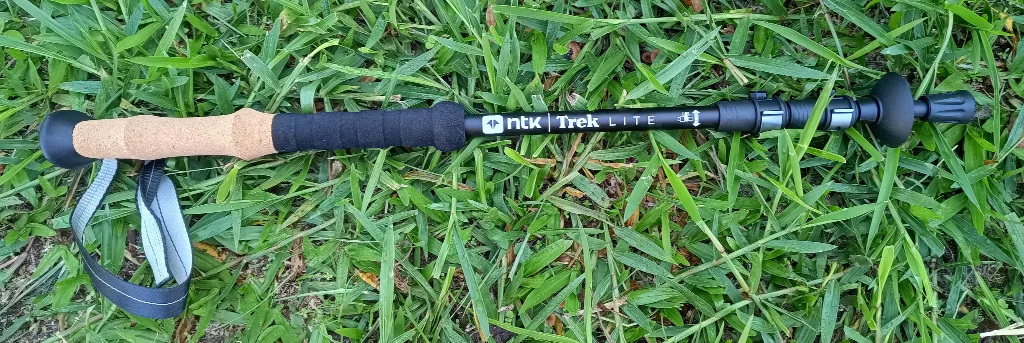

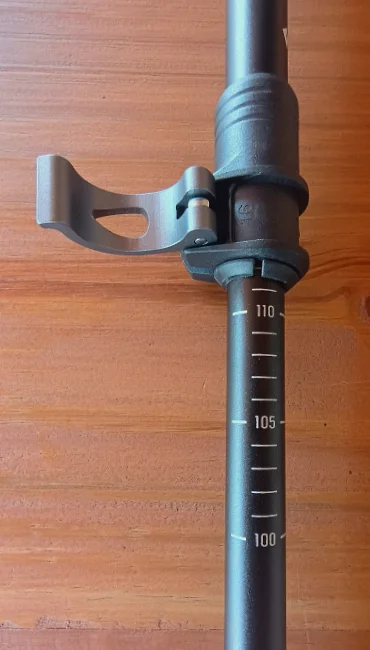
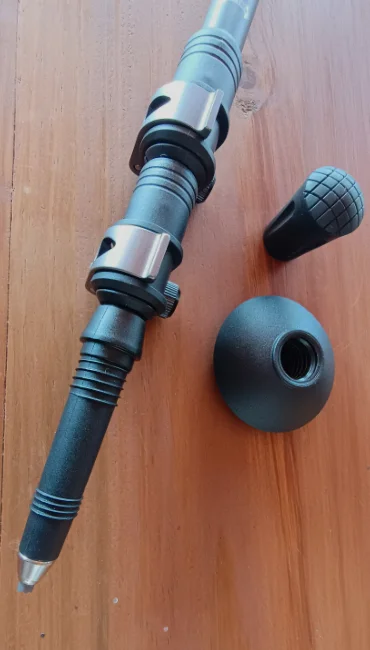
This is a classic pole for hiking and trekking—an ideal first pole for beginner and intermediate users. The flip-locks are practical and easy to operate, and the extended grip adds versatility on the trail.
Take Note
- Lightweight, well-built, and cost-effective;
- Suitable for users of all heights, including children;
- Comes with a small basket and rubber tip;
- Large when collapsed;
- Comfortable extended grip made of cork and EVA. Adjustable strap;
- Centimeter markings on both segments of the pole;
- Great option for those looking for a slightly lighter pole with a good grip, easy adjustment, and good value for money.
Technical Specs
- Grip: ergonomic and extended, made of cork and EVA;
- Wrist strap: adjustable with quality finish;
- Collapsed length: approximately 62 cm;
- Maximum extended length: 135 cm;
- Weight: 255 g without accessories;
- Basket weight: 8 g;
- Rubber tip weight: 14 g;
- Pole material: aluminum;
- Tip material: carbon steel.
NTK Trek Race Trekking Pole
The NTK Trek Race is a very interesting option for users taller than 165 cm who want a compact and comfortable trekking pole. It’s not as light as the Azteq Actos Pro Race Carbon, but it offers an excellent grip and a much more compact size when collapsed compared to the NTK Trek Lite. In fact, the name “NTK Trek Race” feels very fitting—if you occasionally trail run and also enjoy hiking or trekking, this model could meet your needs across those activities.
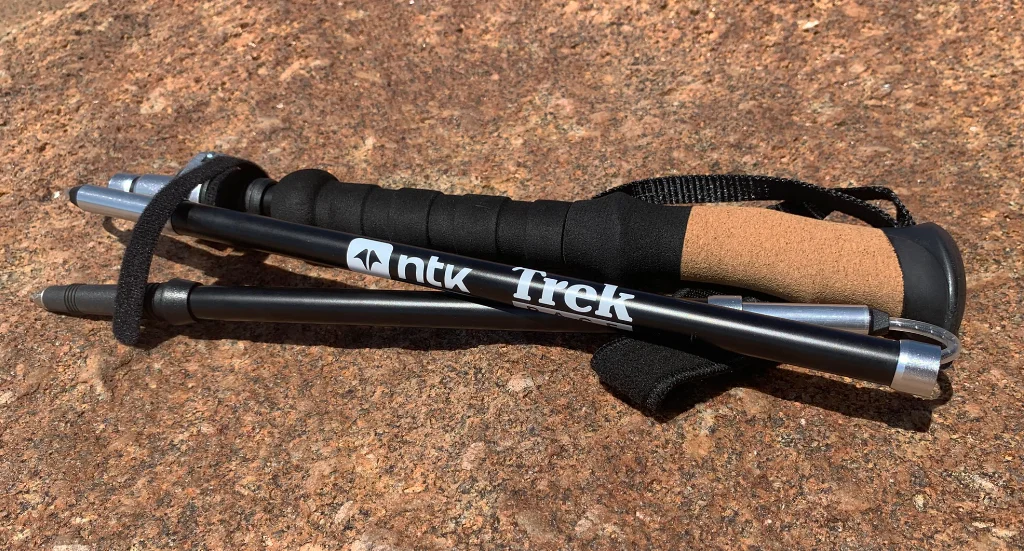
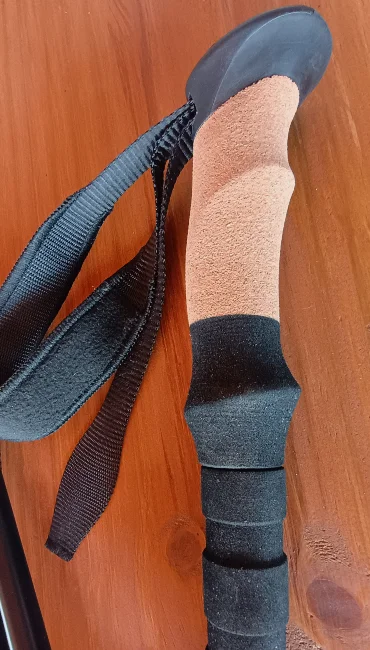
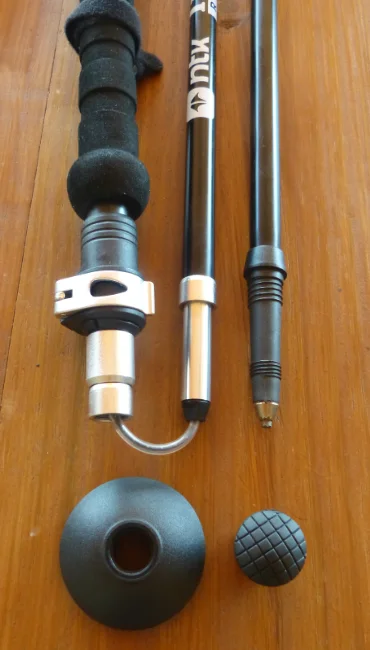
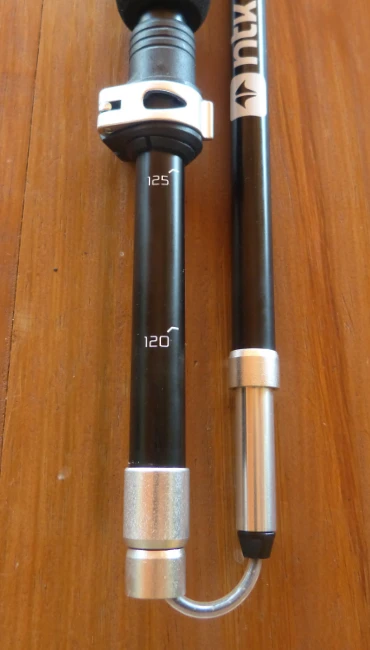
Take Note
- Relatively lightweight, well-built, and cost-effective;
- Ideal for users 165 cm or taller;
- Comes with a small basket and rubber tip;
- Compact when folded;
- Comfortable extended grip made of cork and EVA. Adjustable strap with soft-touch finish;
- Centimeter and inch markings for pole height adjustment;
- A great option for those looking for a compact pole—not super light—but usable for trail running, hiking, and trekking.
Technical Specs
- Grip: ergonomic and extended, made of cork and EVA;
- Wrist strap: adjustable with quality finish;
- Collapsed length: approximately 38 cm;
- Maximum extended length: 135 cm;
- Weight: 290 g without accessories;
- Basket weight: 8 g;
- Rubber tip weight: 14 g;
- Pole material: aluminum 7075;
- Tip material: carbon steel.
Final Remarks and Conclusion
The benefits of trekking poles are undeniable—they help with balance on the trail and reduce strain on joints and muscles. These accessories are especially useful when carrying a heavier load without sacrificing safety, or during river crossings and steep descents. But no pole is unbreakable; all of them can fail during use—regardless of the brand or material. So when investing in a trekking pole, whether for hiking or running, understand the equipment’s limitations and choose one that matches your intended use.
Based on everything we’ve seen, we can group the poles featured in this article by recommended use, considering their individual characteristics:
NTK Trek Pro Antishock and Guepardo Antishock
Basic models recommended for beginner hikers who don’t want to spend much on a trekking pole. The main drawbacks are the locking system and the length when collapsed. The key advantages are the affordable price and usability for people of any height. Ideal for open trails and occasional use. The Guepardo’s grip is smaller, which may be uncomfortable for people with larger hands.
Azteq Actos Aluminum 7075
A compact pole with solid construction, a comfortable grip, and acceptable weight. Its compact size when folded and the extended ergonomic grip are standout features. On the downside, it’s a bit more expensive and not suitable for users shorter than 165 cm. Ideal for hiking and trekking, especially for those who aren’t focused on minimizing gear weight.
Azteq Actos Pro Race Carbon
The lightest model presented in this article. Slightly more expensive due to its carbon construction. Ideal for those who want to optimize weight—whether for trail running or hiking. Like the other compact poles, this one also has the same limitation for users under 165 cm tall.
NTK Trek Lite
A classic aluminum trekking pole for hiking and trekking. When folded, it’s almost as long as the basic models reviewed here—which may be a downside for some users. This pole offers many features that make it a great option for beginner and intermediate users. Good weight, extended and comfortable grip, quick flip-lock adjustment, and suitability for people of all heights.
NTK Trek Race
A versatile pole that can serve beginner trail runners who also want a trekking and hiking option. Like the previous model, this one also offers a great grip and weighs under 300 grams. If you’re taller than 165 cm, this aluminum pole could be a compact and comfortable option.
This post is also available in: Português (Portuguese (Brazil)) Español (Spanish)
